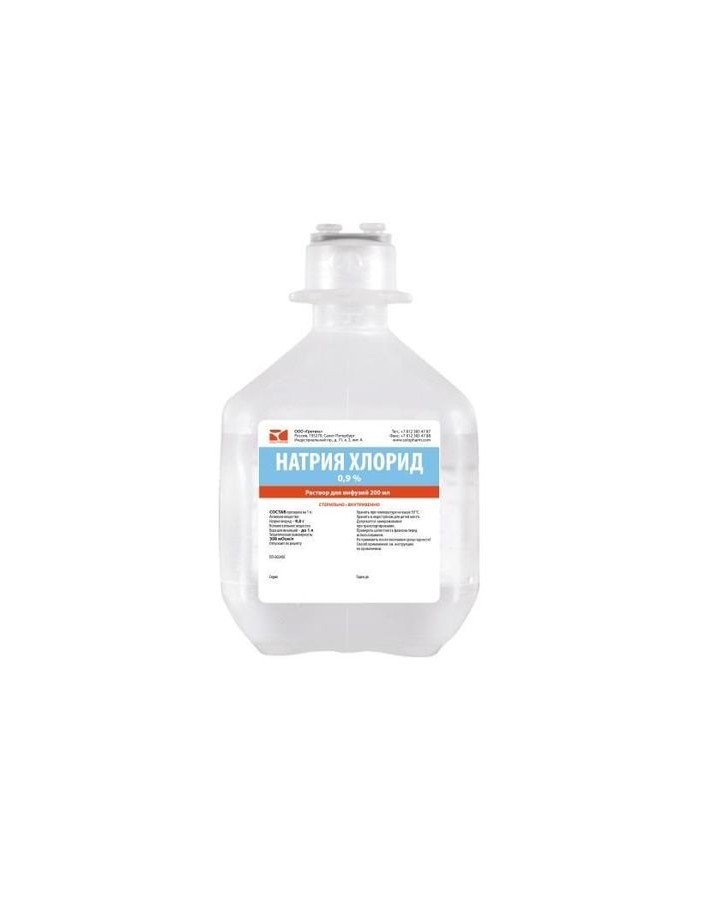




Security policy (edit with Customer reassurance module)

Delivery policy (edit with Customer reassurance module)

Return policy (edit with Customer reassurance module)
Instructions for use
Active ingredients
Sodium chloride
Release form
Injection
Structure
Active ingredient: Sodium chloride Active ingredient concentration (%): 0.9%
Pharmacological effect
Sodium and chlorine ions are the most important inorganic components of the extracellular fluid, maintaining the appropriate osmotic pressure of blood plasma and extracellular fluid. An isotonic solution replenishes the lack of fluid in the body during dehydration. Hypertonic sodium chloride solution with intravenous administration provides a correction of the osmotic pressure of the extracellular fluid and blood plasma. When applied topically in ophthalmology, sodium chloride has a decongestant effect.
Pharmacokinetics
Data on the pharmacokinetics of the drug are not provided.
Indications
Sodium chloride is a saline solution that is used when the body loses extracellular fluid. It is indicated for conditions that lead to a restriction of fluid intake: dyspepsia in case of poisoning; vomiting, diarrhea; cholera; extensive burns; hyponatremia or hypochloremia, in which dehydration is noted. Considering what sodium chloride is, it is used externally for the purpose of washing wounds, eyes , nose. The drug is used to moisten dressings, for inhalations, for the face. It is shown the use of NaCl for forced diuresis in case of constipation, poisoning, with internal bleeding (pulmonary, intestinal, gastric). It is also indicated in the indications for the use of sodium chloride, what is this remedy, which is used to dilute and dissolve drugs that are administered parenterally.
Contraindications
The use of the solution is contraindicated in such diseases and conditions: hypokalemia, hyperchloremia, hypernatremia; extracellular hyperhydration, acidosis; pulmonary edema, cerebral edema; acute left ventricular failure; development of circulatory disorders in which there is a threat of cerebral and pulmonary edema; prescribing large doses of GCS. is prescribed to people who suffer from arterial hypertension, peripheral edema, decompensated chronic heart failure, chronic renal failure, preeclampsia, as well as those who have been diagnosed with other conditions in which sodium retention occurs in the body. If the solution is used as a dissolving agent for other medicines, the existing contraindications should be taken into account.
Precautionary measures
Do not exceed recommended doses.
Application during pregnancy and lactation
The drug should be used with caution during pregnancy and lactation (breastfeeding).
Method of administration and dosage
The instruction for a saline solution (isotonic solution) provides for its administration intravenously and subcutaneously. In most cases, intravenous drip administration is practiced, for which the Sodium Chloride dropper warms up to a temperature of 36-38 degrees. The volume that is administered to the patient depends on the condition of the patient, as well as on the amount of fluid that has been lost by the body. It is important to take into account the person's age and weight. The average daily dose of the drug is 500 ml, the solution is injected at an average rate of 540 ml / h. If there is a strong degree of intoxication, then the maximum volume of the drug per day can be 3000 ml. If there is such a need, you can enter a volume of 500 ml at a rate of 70 drops per minute. Children are administered a dose of 20 to 100 ml per day per 1 kg of body weight. The dosage depends on body weight, on the age of the child. It should be borne in mind that with prolonged use of this medication, it is imperative to control the level of electrolytes in plasma and urine. To dilute drugs that need to be administered drip, 50 to 250 ml of sodium chloride is used per dose of the drug. Determination of the characteristics of the introduction is carried out according to the main drug. The introduction of a hypertonic solution is carried out intravenously. If the solution is used to immediately replenish the deficiency of sodium and chlorine ions, 100 ml of the solution is injected. To conduct a rectal enema to induce defecation, 100 ml of a 5% solution is injected, also 3000 ml of isotonic solution can be injected throughout the day. The use of a hypertensive enema is slowly indicated for renal and cardiac edema, increased intracranial pressure and for hypertension it is carried out slowly, 10-30 ml is injected. It is impossible to carry out such an enema with erosion of the colon and inflammatory processes. Purulent wounds with a solution are carried out in accordance with the scheme prescribed by the doctor. Compresses with NaCl are applied directly to a wound or other skin lesion. Such a compress promotes the separation of pus, the death of pathogenic microorganisms. The nasal spray is instilled into the nasal cavity after it has been cleansed. For adult patients, two drops are instilled into each nostril, for children - 1 drop. It is used for both treatment and prevention, for which the solution is dripped for about 20 days. Sodium chloride for inhalation is used for colds. For this I mix the solution